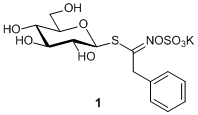Glucosinolate
Glucosinolates are sulfur-containing phytochemicals present in the families Brassicaceae (cabbage, broccoli, mustard, etc.), Capparaceae (capers), etc. There are three major types of glucosinolates, aliphatic, aromatic, and indolic. These types are synthesized from different amino acid precursors: alanine, isoleucine, leucine, methionine, and valine for aliphatic glucosinolates, phenylalanine and tyrosine for aromatic glucosinolates, and tryptophan for indolic glucosinolates.1)
Glucosinolates are hydrolyzed by the endogenous enzyme, myrosinase, to yield isothiocyanates, thiocyanates, nitriles, and elementary sulphur.2) Benzyl isothiocyanate is a product of the enzymatic hydrolysis of glucotropaeolin2,3) and is one of the most intensively studied isothiocyanates as an anti-cancer agent.4-10) The compound shown above is glucotropaeolin potassium salt (1).
References
- 1)Herbivore induction of the glucosinolate-myrosinase defense system: major trends, biochemical bases and ecological significance
- 2)The myrosinase-glucosinolate system, its organisation and biochemistry
- 3)Investigation of the Glucosinolates of Lepidium Sativum growing in Egypt and their biological activity
- H. M. Radwan, M. M. El-Missiry, W. M. Al-Said, A. S. Ismail, K. A. Abdel Shafeek, M. M. Seif-El-Nasr, Res. J. Medicine Med. Sci. 2007, 2, 127.
- 4)Phytochemicals from cruciferous plants protect against cancer by modulating carcinogen metabolism
- 5)Chemoprevention of cancer by isothiocyanates, modifiers of carcinogen metabolism
- 6)Involvement of the mitochondrial death pathway in chemopreventive benzyl isothiocyanate-induced apoptosis
- Y. Nakamura, M. Kawakami, A. Yoshihiro, N. Miyoshi, H. Ohigashi, K. Kawai, T. Osawa, K. Uchida, J. Biol. Chem. 2002, 277, 8492.

- 7)Cell cycle arrest, apoptosis induction and inhibition of nuclear factor kappa B activation in anti-proliferative activity of benzyl isothiocyanate against human pancreatic cancer cells
- 8)Benzyl isothiocyanate targets mitochondrial respiratory chain to trigger reactive oxygen species-dependent apoptosis in human breast cancer cells
- 9)Prevention of mammary carcinogenesis in MMTV-neu mice by cruciferous vegetable constituent benzyl isothiocyanate
- 10)Benzyl isothiocyanate inhibits oncogenic actions of leptin in human breast cancer cells by suppressing activation of signal transducer and activator of transcription 3
The prices are subject to change without notice. Please confirm the newest price by our online catalog before placing an order.
In addition, sales products changes with areas. Please understand that a product is not available when the product details page is not displayed.


